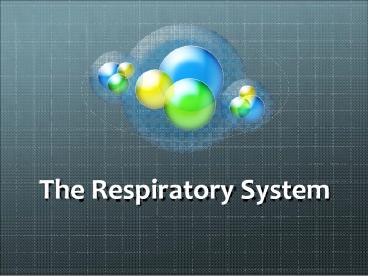The Respiratory System - PowerPoint PPT Presentation
Title:
The Respiratory System
Description:
The Respiratory System Respiratory System Problems 2. Asthma inflammatory condition in which the trachea, bronchi and bronchioles become narrower, making ... – PowerPoint PPT presentation
Number of Views:653
Avg rating:3.0/5.0
Title: The Respiratory System
1
The Respiratory System
2
Bell Ringer
- Try and guess the parts of the body that make up
the respiratory system. - Can you think of any problems related to the
respiratory system? - What do you think is the most important way to
protect your respiratory system?
3
Chatting!! NO MAS!!
4
Anti-Smoking Poster Project!
5
Sneak peak
- http//www.youtube.com/watch?vRPdGQ-A_yM4
6
The Respiratory System is Confusing!
- What is the worlds dumbest question???
- The question you dont ask!!!!
7
Main Function of the Respiratory System
- Respiration
- The exchange of gases between your body and your
environment. - Just like fire needs oxygen to burn, your cells
cannot burn enough fuel to keep you alive
without oxygen.
8
2 Parts of Respiration
- 1. External Respiration
- The exchange of oxygen and carbon dioxide
between the blood and the air in the lungs.
9
External Respiration
- As you breathe, you inhale air that contains
oxygen into your lungs. - That oxygen moves from your lungs into your
blood. - At the same time carbon dioxide moves from your
blood to your lungs.
10
2 Parts of Respiration
- 2. Internal Respiration
- The exchange of gases between the blood and the
cells in the body.
11
Internal Respiration
- Oxygen moves from your blood into your cells.
- Carbon dioxide moves from your cells into your
blood.
12
How Respiration Works
- 1. When you breathe, air enters through your nose
or mouth. - 2. The nasal passage warms the air and contains a
mucous lining and cilia(hairs) to remove dirt and
other particles.
13
Fill in Diagram!
14
How Respiration Works
- 3. After passing though your nasal passage or
mouth, air moves though your larynx (voice box)
which contains your vocal cords.
15
How Respiration Works
- Voice box contains vocal cords which are thin
bands of tissue that vibrate when exhaled air
rushes past them enables you to make sounds.
16
Fill in Diagram
17
How Respiration Works
- 4. After passing through the larynx, air enters
the trachea (wind pipe). - 5. Trachea is about 4.5 inches long surrounded
by rings of cartilage to keep it open so air can
travel through it freely. Lined with cilia.
18
Fill in Diagram!
19
How Respiration Works
- 6. The trachea breaks off into two tubes called
the bronchi. - 7. The bronchi lead into your lungs.
- 8. The bronchi are broken down into smaller
passageways that are called bronchioles. - 9. Think of how a trees branches are made up.
20
Fill in Diagram!
21
(No Transcript)
22
Think, Pair, Share
- Discuss the flow of oxygen through the body so
far.
23
How Respiration Works
- 10. Next air enters the alveoli tiny sacs at
the end of the bronchioles. - 11. This is where external respiration takes
place.
24
Fill in Diagram!
25
How Respiration Works
- 12. The alveoli are lined with tiny blood vessels
called capillaries. - 13. Oxygen is transferred from the alveoli to the
capillaries. - 14. Veins take the oxygen to the cells throughout
the body.
26
(No Transcript)
27
Think, Pair, Share
- Think about external respiration.
- Talk to your partner about what this means and
where it happens. - Answer questions that your partner has or make a
list of questions for me!
28
How Respiration Works
- 15. Our cells use oxygen for energy.
- 16. When this happens carbon dioxide is produced.
- 17. The body needs to get rid of that carbon
dioxide. - 18. This is where internal respiration occurs.
29
Helpers of the Respiratory System
- 1. Diaphragm - large sheet-like muscle that
separates the lungs from the abdominal cavity.
Expands and contracts during respiration. - http//www.youtube.com/watch?vhp-gCvW8PRY
30
Helpers of the Respiratory System
- 2. The pleura is a slick, shiny mucous membrane
that covers the lungs. - 3. The pleura helps minimize friction between the
lungs and the inner wall of the chest. - 4. The cilia are tiny hairs that line the
respiratory tract to filter out dust and dirt
particles.
31
(No Transcript)
32
Respiratory System Problems
- 1. Bronchitis inflammation of the bronchi.
- Symptoms include wheezing, coughing, and
shortness of breath. - Caused by exposure to cigarette smoke, dust,
fumes and other air pollutants.
33
(No Transcript)
34
Respiratory System Problems
- 2. Asthma inflammatory condition in which the
trachea, bronchi and bronchioles become narrower,
making breathing more difficult. - Attacks can be triggered by exertion, emotion,
infections, allergies, or even changes in the
weather. - Asthma attacks are treated with bronchodilators
medications that relax and wide the airways.
35
(No Transcript)
36
Respiratory System Problems
- 3. Pneumonia - alveoli swell and become clogged
with mucus. When the alveoli becomes clogged, gas
exchange become much more difficult. - Symptoms include fever, chest pain, chills, and
cough - MUST see a doctor for antibiotics!!!!
37
(No Transcript)
38
Respiratory System Problems
- 4. Emphysema disease in which the alveoli in
the lungs burst and blend to form fewer, larger
sacs with less surface area. - Disrupts the normal exchange of carbon dioxide
and oxygen in the alveoli. - Causes difficulty breathing, chronic cough
- Almost always caused by smoking. DONT SMOKE!!!
39
(No Transcript)
40
How to Care for the Respiratory System
- Exercise keeps lungs working efficiently
- DONT SMOKE!!!!!
- Avoid exposure to pollutants, including second
hand smoke! - Wash your hands and keep them away from nose and
mouth prevents infection - Maintain good oral health germ in your mouth
can cause infections. BRUSH 2 times a day!!































